BUSN 2019 - AGRIFresh: Impact of Government Intervention Analysis
VerifiedAdded on 2023/03/23
|5
|1050
|27
Report
AI Summary
This report provides an analysis of the business environment of AGRIFresh, an Australian family-owned citrus business operating internationally. It covers the company's background and international operations, focusing on the operational impacts of key risks such as commercial, currency, and cross-cultural risks. The report further examines the impact of globalization on AGRIFresh, including competition, professional expertise, and cultural differences. Finally, it discusses government intervention in the form of regulations, taxation, and subsidies, and their relevance to AGRIFresh's overseas operations. The analysis uses theoretical frameworks and real-world examples to illustrate the challenges and opportunities faced by AGRIFresh in the international market.
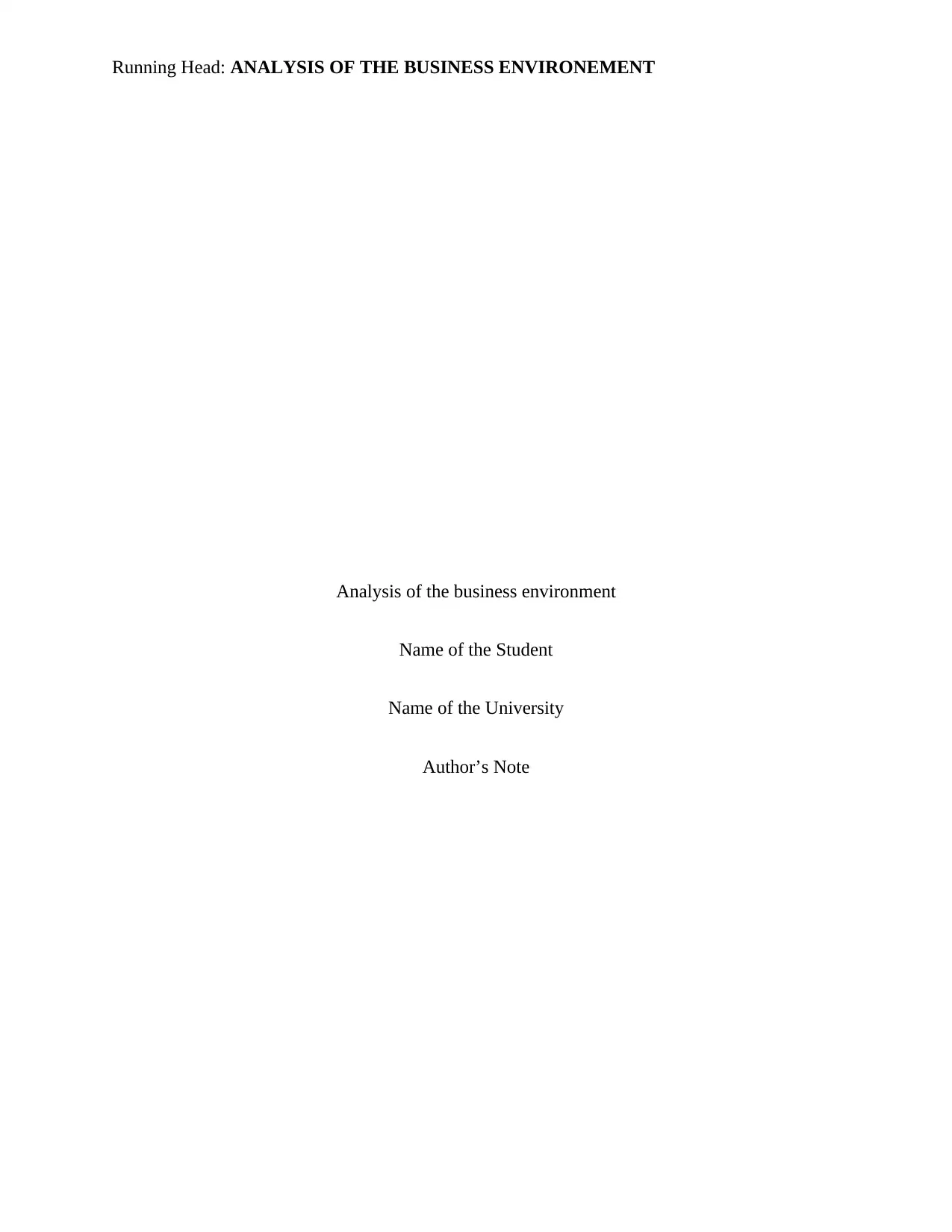
Running Head: ANALYSIS OF THE BUSINESS ENVIRONEMENT
Analysis of the business environment
Name of the Student
Name of the University
Author’s Note
Analysis of the business environment
Name of the Student
Name of the University
Author’s Note
Paraphrase This Document
Need a fresh take? Get an instant paraphrase of this document with our AI Paraphraser
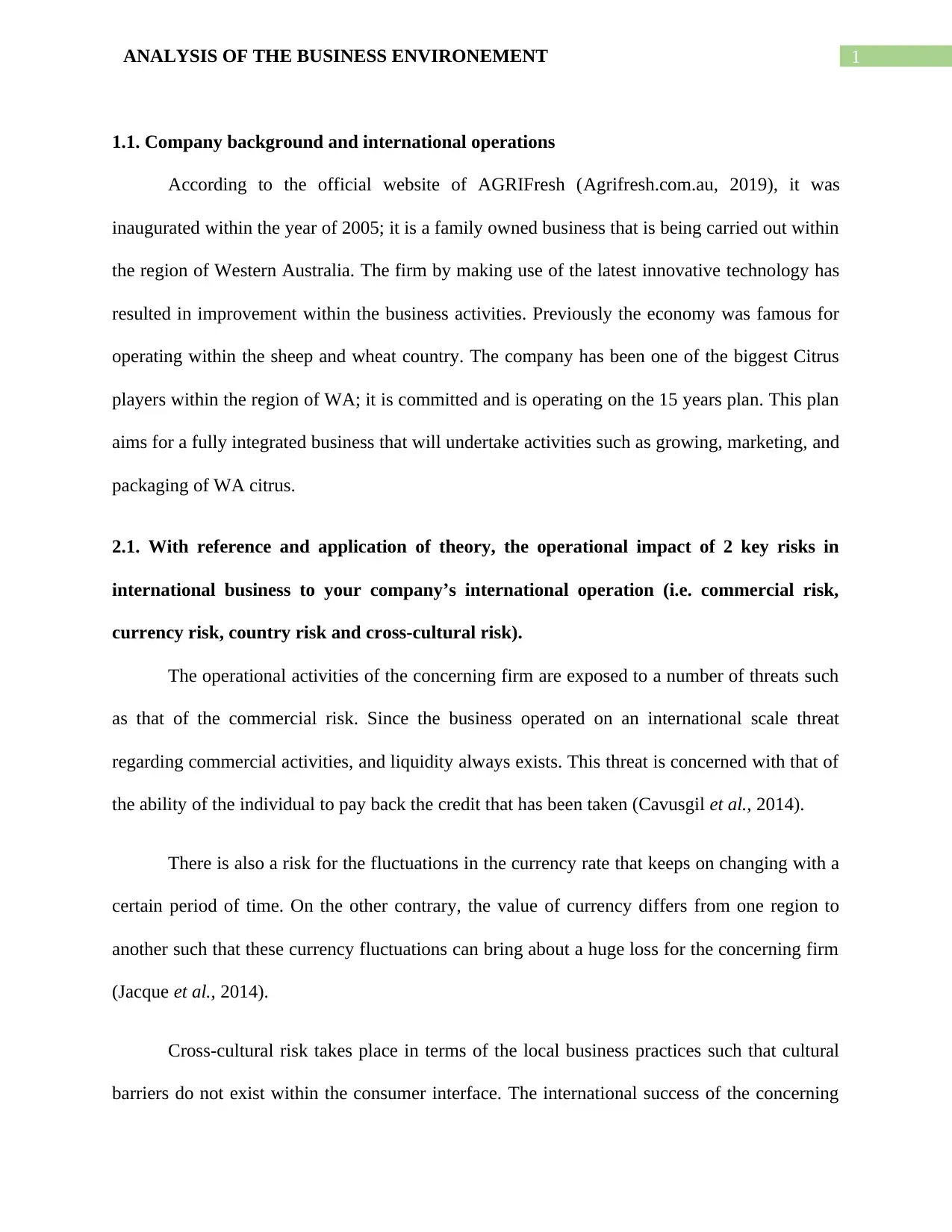
1ANALYSIS OF THE BUSINESS ENVIRONEMENT
1.1. Company background and international operations
According to the official website of AGRIFresh (Agrifresh.com.au, 2019), it was
inaugurated within the year of 2005; it is a family owned business that is being carried out within
the region of Western Australia. The firm by making use of the latest innovative technology has
resulted in improvement within the business activities. Previously the economy was famous for
operating within the sheep and wheat country. The company has been one of the biggest Citrus
players within the region of WA; it is committed and is operating on the 15 years plan. This plan
aims for a fully integrated business that will undertake activities such as growing, marketing, and
packaging of WA citrus.
2.1. With reference and application of theory, the operational impact of 2 key risks in
international business to your company’s international operation (i.e. commercial risk,
currency risk, country risk and cross-cultural risk).
The operational activities of the concerning firm are exposed to a number of threats such
as that of the commercial risk. Since the business operated on an international scale threat
regarding commercial activities, and liquidity always exists. This threat is concerned with that of
the ability of the individual to pay back the credit that has been taken (Cavusgil et al., 2014).
There is also a risk for the fluctuations in the currency rate that keeps on changing with a
certain period of time. On the other contrary, the value of currency differs from one region to
another such that these currency fluctuations can bring about a huge loss for the concerning firm
(Jacque et al., 2014).
Cross-cultural risk takes place in terms of the local business practices such that cultural
barriers do not exist within the consumer interface. The international success of the concerning
1.1. Company background and international operations
According to the official website of AGRIFresh (Agrifresh.com.au, 2019), it was
inaugurated within the year of 2005; it is a family owned business that is being carried out within
the region of Western Australia. The firm by making use of the latest innovative technology has
resulted in improvement within the business activities. Previously the economy was famous for
operating within the sheep and wheat country. The company has been one of the biggest Citrus
players within the region of WA; it is committed and is operating on the 15 years plan. This plan
aims for a fully integrated business that will undertake activities such as growing, marketing, and
packaging of WA citrus.
2.1. With reference and application of theory, the operational impact of 2 key risks in
international business to your company’s international operation (i.e. commercial risk,
currency risk, country risk and cross-cultural risk).
The operational activities of the concerning firm are exposed to a number of threats such
as that of the commercial risk. Since the business operated on an international scale threat
regarding commercial activities, and liquidity always exists. This threat is concerned with that of
the ability of the individual to pay back the credit that has been taken (Cavusgil et al., 2014).
There is also a risk for the fluctuations in the currency rate that keeps on changing with a
certain period of time. On the other contrary, the value of currency differs from one region to
another such that these currency fluctuations can bring about a huge loss for the concerning firm
(Jacque et al., 2014).
Cross-cultural risk takes place in terms of the local business practices such that cultural
barriers do not exist within the consumer interface. The international success of the concerning
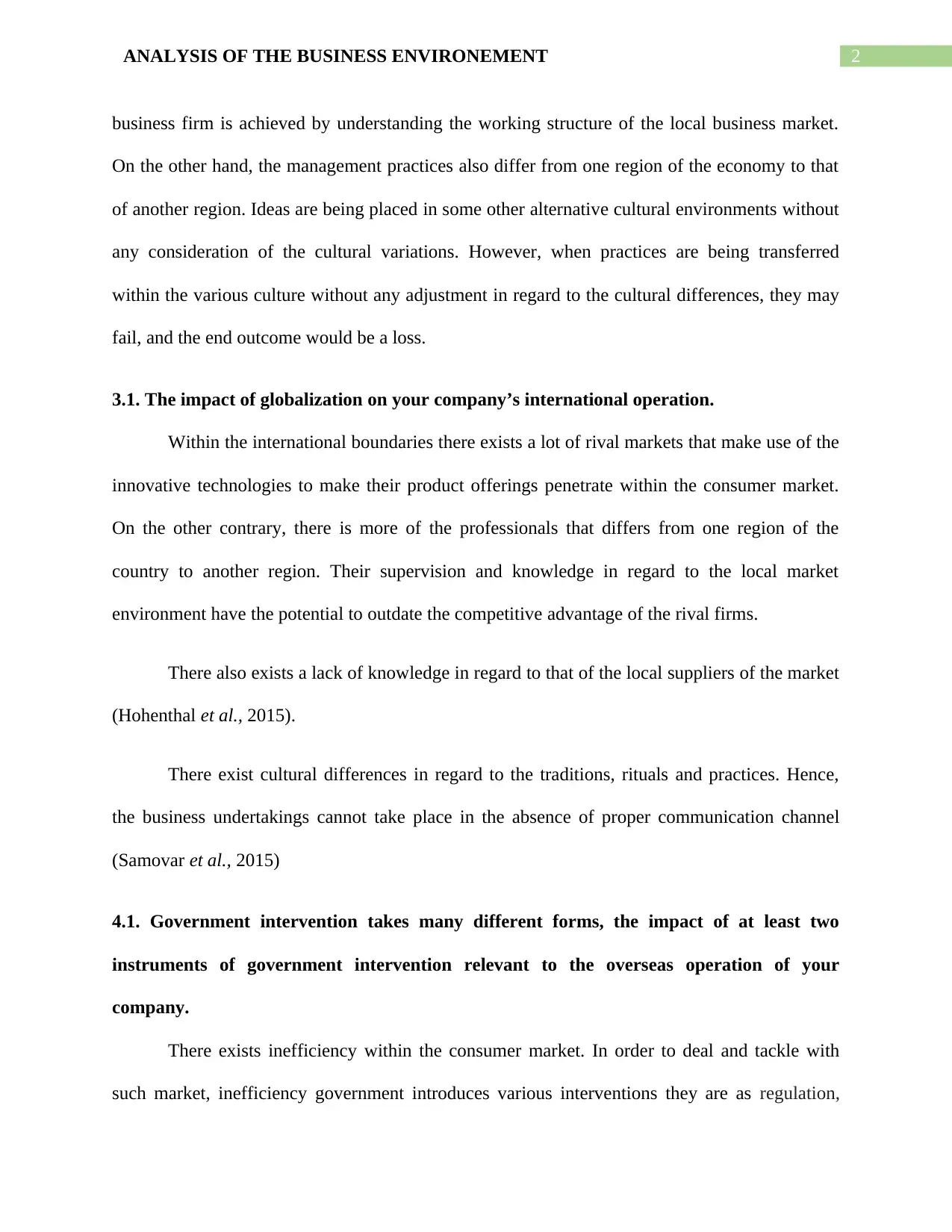
2ANALYSIS OF THE BUSINESS ENVIRONEMENT
business firm is achieved by understanding the working structure of the local business market.
On the other hand, the management practices also differ from one region of the economy to that
of another region. Ideas are being placed in some other alternative cultural environments without
any consideration of the cultural variations. However, when practices are being transferred
within the various culture without any adjustment in regard to the cultural differences, they may
fail, and the end outcome would be a loss.
3.1. The impact of globalization on your company’s international operation.
Within the international boundaries there exists a lot of rival markets that make use of the
innovative technologies to make their product offerings penetrate within the consumer market.
On the other contrary, there is more of the professionals that differs from one region of the
country to another region. Their supervision and knowledge in regard to the local market
environment have the potential to outdate the competitive advantage of the rival firms.
There also exists a lack of knowledge in regard to that of the local suppliers of the market
(Hohenthal et al., 2015).
There exist cultural differences in regard to the traditions, rituals and practices. Hence,
the business undertakings cannot take place in the absence of proper communication channel
(Samovar et al., 2015)
4.1. Government intervention takes many different forms, the impact of at least two
instruments of government intervention relevant to the overseas operation of your
company.
There exists inefficiency within the consumer market. In order to deal and tackle with
such market, inefficiency government introduces various interventions they are as regulation,
business firm is achieved by understanding the working structure of the local business market.
On the other hand, the management practices also differ from one region of the economy to that
of another region. Ideas are being placed in some other alternative cultural environments without
any consideration of the cultural variations. However, when practices are being transferred
within the various culture without any adjustment in regard to the cultural differences, they may
fail, and the end outcome would be a loss.
3.1. The impact of globalization on your company’s international operation.
Within the international boundaries there exists a lot of rival markets that make use of the
innovative technologies to make their product offerings penetrate within the consumer market.
On the other contrary, there is more of the professionals that differs from one region of the
country to another region. Their supervision and knowledge in regard to the local market
environment have the potential to outdate the competitive advantage of the rival firms.
There also exists a lack of knowledge in regard to that of the local suppliers of the market
(Hohenthal et al., 2015).
There exist cultural differences in regard to the traditions, rituals and practices. Hence,
the business undertakings cannot take place in the absence of proper communication channel
(Samovar et al., 2015)
4.1. Government intervention takes many different forms, the impact of at least two
instruments of government intervention relevant to the overseas operation of your
company.
There exists inefficiency within the consumer market. In order to deal and tackle with
such market, inefficiency government introduces various interventions they are as regulation,
⊘ This is a preview!⊘
Do you want full access?
Subscribe today to unlock all pages.

Trusted by 1+ million students worldwide
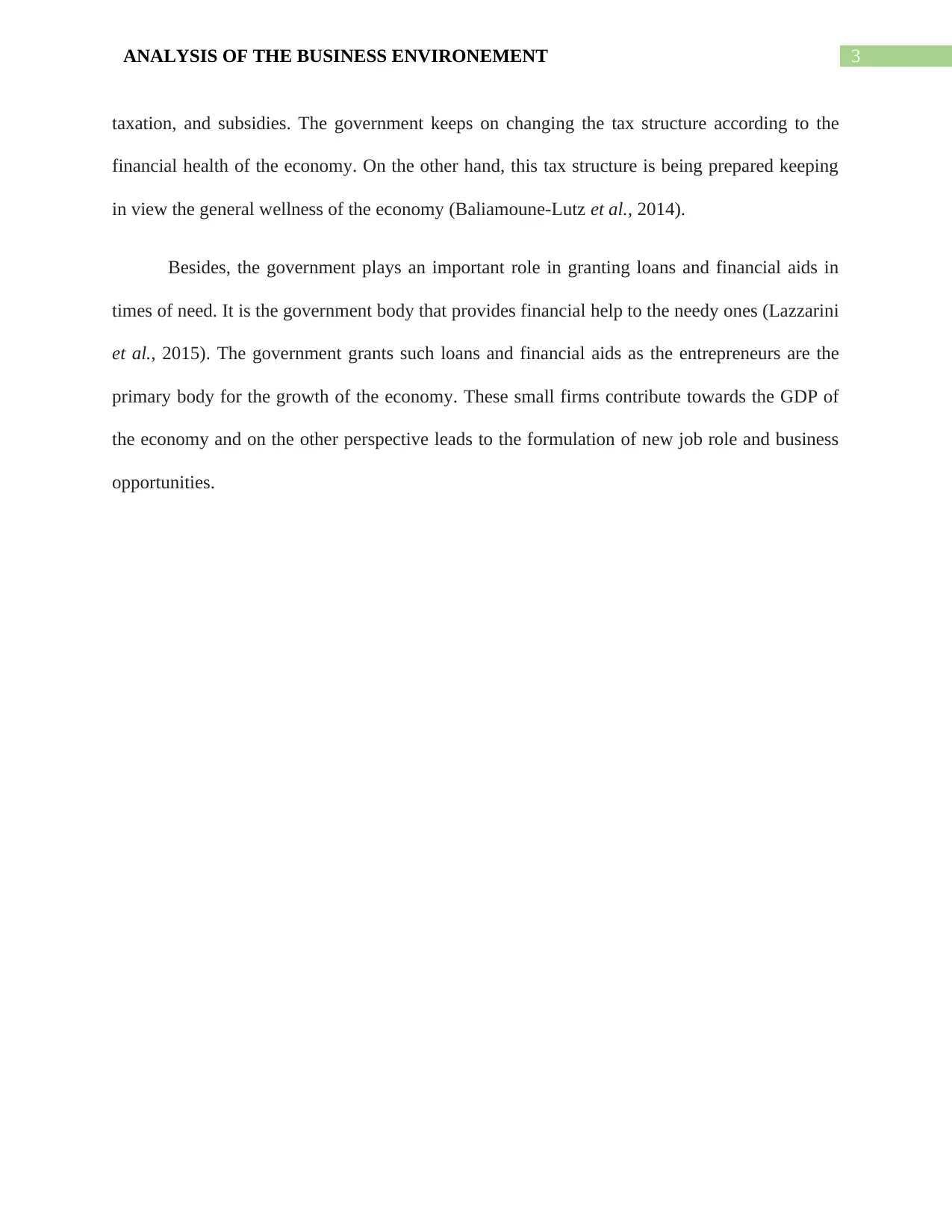
3ANALYSIS OF THE BUSINESS ENVIRONEMENT
taxation, and subsidies. The government keeps on changing the tax structure according to the
financial health of the economy. On the other hand, this tax structure is being prepared keeping
in view the general wellness of the economy (Baliamoune-Lutz et al., 2014).
Besides, the government plays an important role in granting loans and financial aids in
times of need. It is the government body that provides financial help to the needy ones (Lazzarini
et al., 2015). The government grants such loans and financial aids as the entrepreneurs are the
primary body for the growth of the economy. These small firms contribute towards the GDP of
the economy and on the other perspective leads to the formulation of new job role and business
opportunities.
taxation, and subsidies. The government keeps on changing the tax structure according to the
financial health of the economy. On the other hand, this tax structure is being prepared keeping
in view the general wellness of the economy (Baliamoune-Lutz et al., 2014).
Besides, the government plays an important role in granting loans and financial aids in
times of need. It is the government body that provides financial help to the needy ones (Lazzarini
et al., 2015). The government grants such loans and financial aids as the entrepreneurs are the
primary body for the growth of the economy. These small firms contribute towards the GDP of
the economy and on the other perspective leads to the formulation of new job role and business
opportunities.
Paraphrase This Document
Need a fresh take? Get an instant paraphrase of this document with our AI Paraphraser
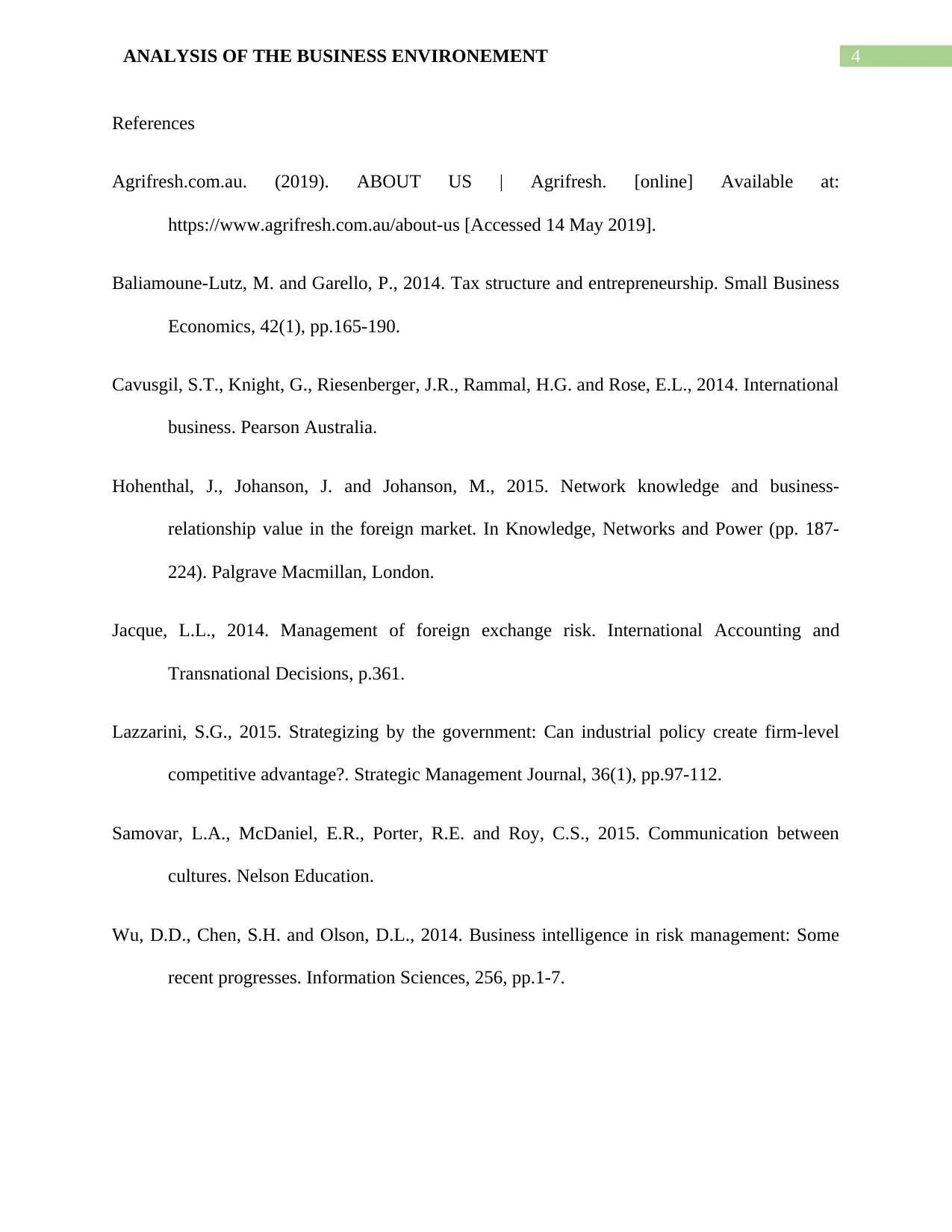
4ANALYSIS OF THE BUSINESS ENVIRONEMENT
References
Agrifresh.com.au. (2019). ABOUT US | Agrifresh. [online] Available at:
https://www.agrifresh.com.au/about-us [Accessed 14 May 2019].
Baliamoune-Lutz, M. and Garello, P., 2014. Tax structure and entrepreneurship. Small Business
Economics, 42(1), pp.165-190.
Cavusgil, S.T., Knight, G., Riesenberger, J.R., Rammal, H.G. and Rose, E.L., 2014. International
business. Pearson Australia.
Hohenthal, J., Johanson, J. and Johanson, M., 2015. Network knowledge and business-
relationship value in the foreign market. In Knowledge, Networks and Power (pp. 187-
224). Palgrave Macmillan, London.
Jacque, L.L., 2014. Management of foreign exchange risk. International Accounting and
Transnational Decisions, p.361.
Lazzarini, S.G., 2015. Strategizing by the government: Can industrial policy create firm‐level
competitive advantage?. Strategic Management Journal, 36(1), pp.97-112.
Samovar, L.A., McDaniel, E.R., Porter, R.E. and Roy, C.S., 2015. Communication between
cultures. Nelson Education.
Wu, D.D., Chen, S.H. and Olson, D.L., 2014. Business intelligence in risk management: Some
recent progresses. Information Sciences, 256, pp.1-7.
References
Agrifresh.com.au. (2019). ABOUT US | Agrifresh. [online] Available at:
https://www.agrifresh.com.au/about-us [Accessed 14 May 2019].
Baliamoune-Lutz, M. and Garello, P., 2014. Tax structure and entrepreneurship. Small Business
Economics, 42(1), pp.165-190.
Cavusgil, S.T., Knight, G., Riesenberger, J.R., Rammal, H.G. and Rose, E.L., 2014. International
business. Pearson Australia.
Hohenthal, J., Johanson, J. and Johanson, M., 2015. Network knowledge and business-
relationship value in the foreign market. In Knowledge, Networks and Power (pp. 187-
224). Palgrave Macmillan, London.
Jacque, L.L., 2014. Management of foreign exchange risk. International Accounting and
Transnational Decisions, p.361.
Lazzarini, S.G., 2015. Strategizing by the government: Can industrial policy create firm‐level
competitive advantage?. Strategic Management Journal, 36(1), pp.97-112.
Samovar, L.A., McDaniel, E.R., Porter, R.E. and Roy, C.S., 2015. Communication between
cultures. Nelson Education.
Wu, D.D., Chen, S.H. and Olson, D.L., 2014. Business intelligence in risk management: Some
recent progresses. Information Sciences, 256, pp.1-7.
1 out of 5
Related Documents
Your All-in-One AI-Powered Toolkit for Academic Success.
+13062052269
info@desklib.com
Available 24*7 on WhatsApp / Email
![[object Object]](/_next/static/media/star-bottom.7253800d.svg)
Unlock your academic potential
Copyright © 2020–2025 A2Z Services. All Rights Reserved. Developed and managed by ZUCOL.





